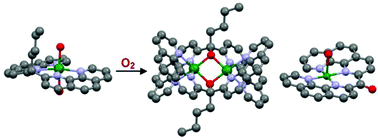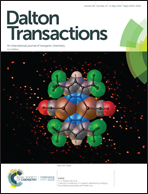Aerobic oxygenation catalyzed by first row transition metal complexes coordinated by tetradentate mono-carbon bridged bis-phenanthroline ligands: intra- versus intermolecular carbon–hydrogen bond activation†
Abstract
Commonly, iron(II) and copper(I) complexes bind dioxygen (O2) and then activate O2 through a reductive reaction pathway. There is, however, significant interest in low temperature oxygenation with O2 without the use of a sacrificial reductant. Here, earth-abundant metal complexes (FeII, CoII, NiII and CuII) coordinated by two different tetra-dentate mono-carbon bridged bis-phenanthroline ligands, (1,10-Phen)2-2,2′-CR1R2, where R1 = n-butyl and R2 = n-butyl or H were synthesized. The structures all showed the expected metal complexation in the equatorial plane by the bridged bis-phenanthroline ligands. For R1 = n-butyl; R2 = H, where the ligand has a tertiary carbon bridging group, fast intramolecular oxygenation occurred at the pseudobenzylic position. Depending on the transition metal the main products formed were oxygen bridged dimers of the metal complexes (Co and Fe) or metal complexes with a carbonyl moiety at the bridging pseudobenzylic position as a result of C–R1 bond cleavage (Ni and Cu). The different product assemblages are explained by different reaction pathways that are metal specific. For quaternary carbon bridged ligands, R1 = R2 = n-butyl, the complexes catalytically activated C–H bonds of cyclohexene under catalytic conditions, showing higher effective turnover numbers at low catalyst loading. The reactivity observed is commensurate with a room temperature autooxidation reaction although the initiation of the free radical reaction is metal specific. In general labelling studies with 18O2, UV-vis and EPR spectroscopy as well as cyclic voltammetry measurements led to a conclusion that the reaction pathways involved both C–H bond activation and O2 activation.



 Please wait while we load your content...
Please wait while we load your content...